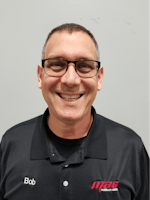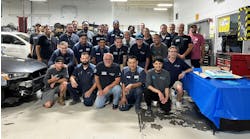There are many traditional repairs that are just not viable today. This is becoming more and more evident with ADAS (advanced driver-assistance systems) systems, especially as they evolve. Recently I was helping perform a blind spot calibration at the MAS (Mobile Auto Solutions) calibration center on a 2018 VW Atlas. The vehicle was damaged in the sensor area. The initial calibration showed the sensor to be at 6 degrees (Figure 1), the spec is +/-5 degrees. Needing to remove the bumper cover for inspection, we found that the quarter panel had obviously been repaired (Figure 2). This got me thinking about how many repairs we find today that were at one time acceptable to the shop and the insurance companies. With the onset of ADAS, all parties must understand that repair standards have to change. My goal in this article is to show examples of repairs that illustrate why body shops and insurance companies must adapt to the new higher standards set forth by the OEMs.
I’ll start with the Atlas from above. The repairs already performed to the quarter panel were exceptional for a vehicle without any ADAS type features; it was not sufficient for the calibration to pass. In this case, after the bumper cover was removed, the quarter panel was able to be adjusted enough, which brought the sensor into spec, using a mallet. Normally blind spot calibrations performed by MAS are performed at the body shop location; however, due to the complexity of VW/Audi ADAS alignment systems, the calibration tools are not portable. This requires the vehicle to be brought to our calibration center. Everyone who works for us has worked in the mechanical repair field and all are highly skilled with electronics — we are not body techs. Since the vehicle is at our location, we are forced to become body techs, unless the vehicle is towed back and forth numerous times, which is not acceptable to us. Pulling a bumper cover is not that big of a deal, I’ve had to do that just to replace a timing belt years ago. The real trick is to bend metal without it looking unprofessional. I initially start tapping very carefully, like a little girl petting her horse. After performing the calibration a couple times without any noticeable change, I start smacking the quarter panel like a lumberjack looking to take down a sequoia. In the end, this sensor is calibrated to .7 degrees (Figure 3).
Another example of a vehicle MAS has worked on was a 2010 Toyota Rav4. We were called out to perform a BSM (blind spot monitor) calibration. The sensor was unable to find the target, resulting in the bumper being removed. As shown in Figures 4 and 5, the quarter panel is still visibly damaged; the sensor bracket was welded on but the area was never painted or completed. This is a case where we told the shop to repair the area properly and call us back when ready for the calibration.
Another Toyota that I looked at was a 2015 Rav4; the shop also requested a BSM calibration. The shop stated that it had been a year since they had performed repairs and were sure that this issue was not related. I set up and ran the calibration only to find that it failed. I instructed the shop to remove the bumper and once again found visible damage in the sensor area. After looking at the estimate for the repairs, I noticed the vehicle had only been driven about 1,500 miles over the last year. These sensors are, from my understanding and codes that I’ve seen, in a constant state of self-test and self-calibration verification. I assured the shop that this was related damage, since many times calibration-related faults appear after the vehicle is driven for a while. I assisted the body tech in straightening the quarter panel to a point that the calibration passed at .7 degrees, well within the published spec of +/- 3.6 degrees.
One shop called us out to perform a wiring repair on a 2017 Subaru Forester for the BSM connector. Before the wiring repair was made, I pointed out that the sensor appears to be visually out of place (Figure 6). If I had not paid attention, this vehicle would have been delivered and could have been potentially hazardous to a driver relying on this system.
The most recent ADAS calibration that MAS encountered was on a 2018 Honda Accord. The shop said that there were several ADAS warning messages displayed and requested an inspection. Upon an initial scan we found that the millimeter wave radar sensor was in need of a calibration. When the calibration failed, the tech asked that the bumper be removed so he could inspect or adjust the sensor. Once the bumper was removed, work stopped and the general manager was informed of the work that needed to be performed (Figure 7). Those that follow us on Facebook have already seen this photo. This type of repair is completely unacceptable and should never be performed on a vehicle like this. These types of repairs and lack of proper inspections with OEM equipment and qualified personnel put people’s lives in jeopardy.
What are some of the options that are available to shops so that these issues are avoided? First, a pre-scan of the vehicle would give an indication of a problem that needs further attention. Second, a tear-down process would ensure that the estimator is working with the body tech so these issues can be resolved during the repair process. We have a number of shops that will include MAS in the repair process to assure that the calibration will pass without any disassembly after completion. This way of repairing the vehicle has proven to these shops to help drop cycle time, sometimes dramatically. One of the coolest ways to insure a proper repair is to employ a tool such at the Matrix Wand (Figures 8, 9). I’ve had the pleasure of working with a shop that has a Matrix Wand; it was a very easy process to map out how far out the quarter panel was. Once it was mapped out, the process to bring the BSM sensor into spec was rather quick. While I’ve not seen the Spanesi Touch in action on one of these repairs, I would think it may have the ability for similar end results.
With the advent of ADAS systems, it is becoming more important than ever to change how we address vehicle repairs. We must be sure the vehicles are leaving with the proper OEM service procedures followed, including any required calibrations. I have laid out a few examples of vehicles that appeared to be repaired properly but ended having potentially life-threatening consequences. They illustrate how yesterday’s repairs are not measuring up to today’s requirements. As time goes on, we are going to see a need to slow the process down a little to insure a properly repaired vehicle. Take the time to verify the repair procedure with OEM service information before, the start of the repair process. Someday in the near future, the use of new OEM parts will be a requirement, as well as having access to OEM scan tools and calibration tooling becoming the new normal. Finding the people to fill these needs has already become disturbingly difficult.



